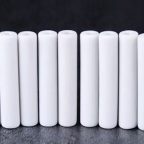Grinding usually refers to the use of micron-scale abrasive particles with a hardness that is farther away from the material to be processed, and the micro-cutting and rolling action generated by the hard grinding disc to achieve the removal of trace materials on the machined surface, so that the shape and size of the workpiece are accurate. Reach the required value, reduce the surface roughness, and reduce the machining method of machining the metamorphic layer.
1. Grinding Mechanism
Advanced ceramic materials are hard and brittle materials that are difficult to machine. In the grinding process of such materials, the material to be processed is removed by the rolling action or micro-cutting action of abrasive particles. When grinding hard and brittle materials, it is important to control the size and uniformity of the resulting cracks.
On the one hand, it is necessary to ensure that no major damage occurs on the surface during machining; on the other hand, in order to improve the machining efficiency, it is necessary to promote micro-breaking. By choosing the particle size of the abrasive particles and controlling the uniformity of the particle size, particularly large machining defects can be avoided.
2. Characteristics of grinding machining
- Micro-cutting Because there are many abrasive grains distributed between the workpiece and the grinding tool, the load on a single abrasive grain is very small, and by controlling the appropriate machining load range, a back cut of less than 1 m can be obtained. Tool amount, to achieve micro-cutting of workpiece material.
- Forming according to the evolutionary principle When the grinding tool is in contact with the workpiece, under the action of the non-mandatory grinding pressure, it can automatically select local convexities for machining, so only the material at the two protrusions is removed, so that the grinding tool and the workpiece are Trim each other and gradually increase the accuracy.
The accuracy of ultra-precision grinding is almost irrelevant to the motion accuracy of the machine tool that constitutes the relative motion. It is mainly determined by the contact properties and pressure characteristics between the workpiece and the grinding tool, as well as the shape of the relative motion trajectory. Under suitable conditions, the machining accuracy can exceed the accuracy of the machine tool itself, so this kind of machining is called evolution machining. In order to obtain an ideal machined surface, it is required that:
- The grinding tool and the workpiece can be trimmed each other;
- Try to make the relative motion trajectory of each point on the machined surface and the grinding disc not repeated, so as to reduce the geometrical error of the grinding tool surface and the impact on the workpiece surface. It can reduce the “copy” phenomenon caused by the shape, and at the same time reduce the scratch depth and surface roughness; ③ On the premise that the grinding tool has an ideal geometric shape, the floating grinding disc can ensure the surface machining accuracy.
3.Multi-edge multi-directional cutting
In the grinding process, due to the incomplete shape of each abrasive particle and the randomness of distribution, when the abrasive particles slide and roll on the workpiece, multi-directional cutting can be achieved, and the entire abrasive particle can be cut in multiple directions.
The cutting opportunity and the cutting edge breakage rate are equal, and automatic sharpening can be realized. By increasing the contact area, contact pressure and relative moving distance between the workpiece and the abrasive particles, and reducing the half apex angle of the abrasive particle cone, the machining efficiency can be improved; , and increase the yield point of the workpiece, the half apex angle of the abrasive grain cone and the abrasive grain rate, which can reduce the surface roughness.
Pintejin machining ceramic service include : Alumina Ceramic Parts, Zirconia Ceramic, Silicon Carbide Ceramic, CNC Machined Aluminum Nitride Ceramic, Machinable Ceramic Parts, Glass Ceramic,Macor Ceramic,Powder Metallurgy Dies,Ceramic Injection Molding,Ceramic Dry Pressing,Ceramic Extrusion Dies




